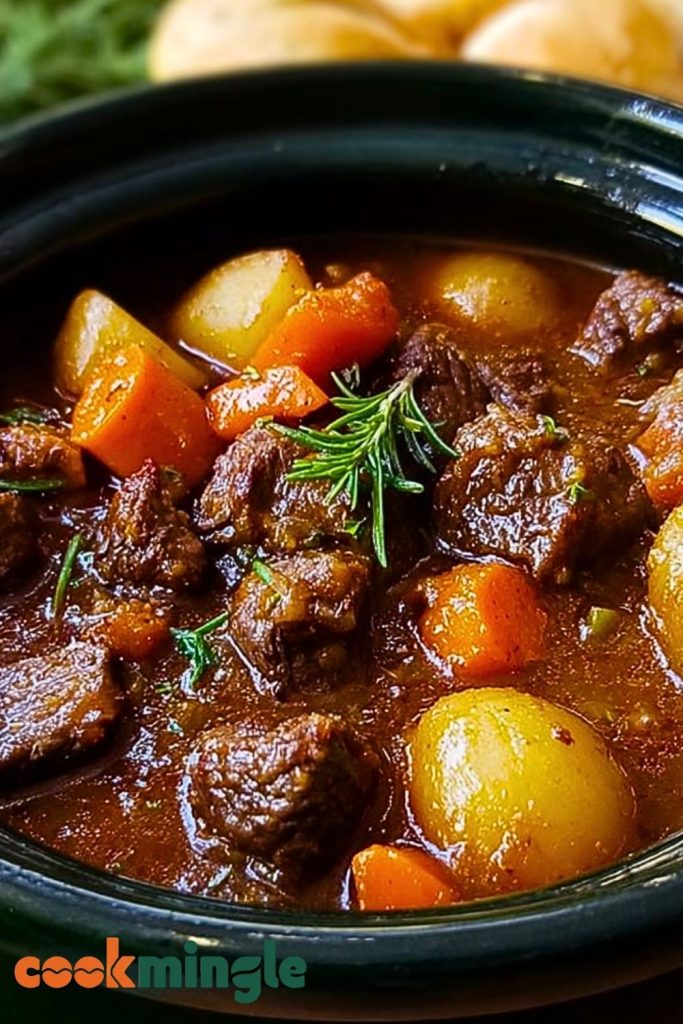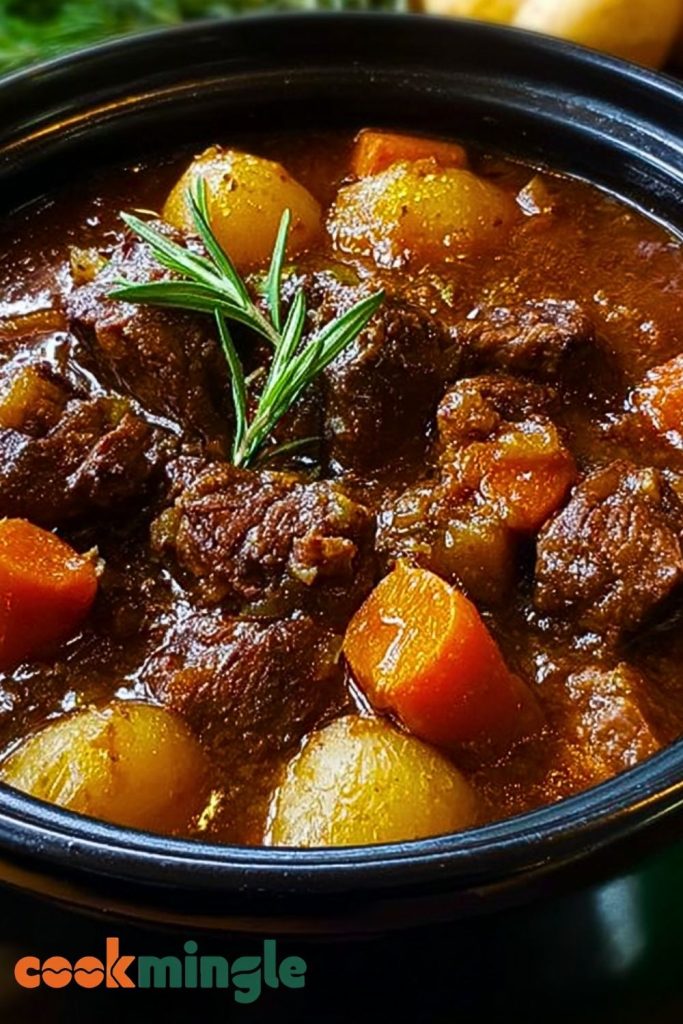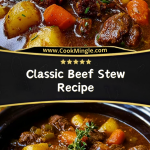There’s just something soul-soothing about a pot of hearty beef stew simmering away on the stove. The aroma alone is enough to wrap you in a warm hug, and the first spoonful? It’s comfort in its purest form. I’ve always turned to this Classic Beef Stew recipe when the weather cools or when I just need a meal that feels like home. The rich, savory broth, melt-in-your-mouth chunks of beef, and tender vegetables make this dish an unbeatable staple in my kitchen.

What I love most about this stew is how the ingredients work in harmony—nothing fancy, just wholesome components layered with deep, slow-cooked flavor. Whether it’s a casual family dinner or a dish to impress friends, this stew delivers. Once you make it from scratch, you’ll never want to go back to canned versions again.
Why You’ll Love This Classic Beef Stew Recipe
- Ultimate Comfort Food: Every bite feels like a cozy night by the fireplace.
- Simple Ingredients, Big Flavor: Pantry basics turn into something extraordinary.
- Great for Meal Prep: Tastes even better the next day!
- Freezer-Friendly: Make a big batch and freeze leftovers for busy days.
- Crowd-Pleaser: Perfect for gatherings, holidays, or quiet nights in.
What Kind of Beef Should I Use for Classic Beef Stew?
For this stew, I always go with chuck roast. It has just the right amount of marbling, which means it gets incredibly tender after a slow cook and brings a deep, beefy flavor to the broth. If chuck isn’t available, stew meat sold pre-cut at most grocery stores is an easy alternative, though you may sacrifice a bit of tenderness depending on the cuts they mix in.
Another excellent option is brisket, which breaks down beautifully over time, or bottom round, which is leaner but still works well with longer cook times. The key is choosing a cut that benefits from slow simmering—this isn’t the time for quick-cook steaks.
Options for Substitutions
One of the things I appreciate about this recipe is how forgiving it is. If you’re short on an ingredient or want to customize, here’s what you can swap:
- Vegetables: Don’t have carrots or potatoes? Try parsnips, turnips, or sweet potatoes. Even celery root works.
- Beef broth: A rich vegetable broth or mushroom broth can be used if you’re reducing red meat.
- Tomato paste: Swap in crushed tomatoes or even a little red wine for depth.
- Flour (for thickening): Cornstarch or arrowroot powder works well for gluten-free options.
- Fresh herbs: No fresh thyme or rosemary? Dried herbs are fine—just reduce the amount by half.
Substitutions can bring a fresh twist or help you use what you already have. It’s all about making the stew your own.
Ingredients for This Classic Beef Stew Recipe
Each ingredient in this stew plays a specific role—building richness, texture, and comfort in every spoonful. Here’s what you’ll need and why it matters:
- Beef chuck roast – The heart of the stew, this cut becomes incredibly tender and flavorful when simmered slowly.
- Yellow onions – They bring sweetness and depth as they soften and melt into the broth.
- Garlic cloves – A must-have for an aromatic base with a subtle punch.
- Carrots – Add color, natural sweetness, and that unmistakable stew texture.
- Baby potatoes – These hold their shape well and soak up all the delicious broth.
- Tomato paste – Brings a concentrated umami richness that balances the savory broth.
- Beef broth – The liquid gold that ties everything together and builds a deep, meaty base.
- All-purpose flour – Helps thicken the stew to a comforting, spoon-coating consistency.
- Olive oil – Used to sear the beef and develop a rich, caramelized flavor.
- Fresh thyme & rosemary – These herbs infuse the stew with earthy, fragrant notes.
- Bay leaves – They quietly add background complexity during the long simmer.
- Salt and black pepper – Essential for seasoning and enhancing all other flavors.

Step 1: Sear the Beef
Start by cutting your chuck roast into 1.5-inch cubes and pat them dry with paper towels—this helps them brown beautifully. Heat olive oil in a large Dutch oven over medium-high heat. Working in batches, sear the beef on all sides until deeply browned. This step locks in flavor and creates a rich base for the stew.
Step 2: Sauté the Aromatics
Once the beef is done, reduce the heat to medium and add chopped onions to the same pot. Sauté until translucent and lightly golden, then stir in minced garlic and tomato paste. Cook for 1–2 minutes until the tomato paste darkens slightly—this intensifies the stew’s flavor.
Step 3: Deglaze and Build the Base
Pour in a splash of beef broth (or red wine if using) and scrape up the browned bits from the bottom of the pot—this is pure flavor gold. Add the rest of the broth and stir to combine. Return the seared beef to the pot along with any juices it released.
Step 4: Add Vegetables and Seasonings
Toss in the chopped carrots and baby potatoes, then add thyme, rosemary, bay leaves, salt, and pepper. Give everything a good stir to make sure the flavors are evenly distributed.
Step 5: Simmer Low and Slow
Bring the pot to a gentle boil, then reduce the heat to low. Cover and let it simmer for about 2 to 2½ hours, stirring occasionally. The beef should be fork-tender and the broth rich and slightly thickened.
Step 6: Thicken if Needed
If you prefer a thicker stew, mix a tablespoon of flour or cornstarch with a bit of cold water and stir it into the pot during the last 15 minutes of cooking. Let it simmer uncovered until it reaches your desired consistency.
How Long to Cook the Classic Beef Stew
Classic beef stew is all about slow, gentle cooking to break down the meat and build deep flavor. After searing the beef and sautéing the aromatics, you’ll want to let everything simmer for 2 to 2½ hours over low heat.
The beef should be fork-tender, and the vegetables soft but not falling apart. If you’re using a slow cooker, aim for 8 hours on low or 4–5 hours on high. And if you’re going with a pressure cooker, 35–40 minutes under pressure does the trick, followed by a natural release.
Tips for Perfect Classic Beef Stew
- Brown the beef in batches: Overcrowding the pan leads to steaming instead of searing. That rich, brown crust is essential for flavor.
- Deglaze the pot: Don’t skip scraping up the browned bits—they’re packed with umami and make your broth amazing.
- Cut veggies evenly: Uniform pieces cook more evenly and give the stew a polished, cohesive texture.
- Don’t rush the simmer: Low and slow is the key to tender meat and rich flavor.
- Taste and adjust seasoning: The flavors develop over time, so give it a final taste before serving and adjust salt or pepper if needed.
- Remove herb stems and bay leaves before serving: They’ve done their job and can be a bit intrusive if left in.
- Let it rest: Like many stews, it’s even better after sitting for a few hours or overnight in the fridge.
Watch Out for These Mistakes While Cooking
Even a simple, rustic dish like beef stew can go sideways with a few missteps. Here’s what to avoid:
- Skipping the sear: That initial browning step isn’t optional. It’s where the stew gets its deep, beefy flavor.
- Adding all the vegetables too early: Carrots and potatoes don’t need as long as beef to cook. Add them after the stew has been simmering for a bit to avoid mushy results.
- Boiling instead of simmering: A rapid boil will toughen your meat. Keep the heat low for a gentle simmer.
- Not seasoning in stages: Salt and pepper should be layered as you cook—not just dumped in at the end.
- Using lean cuts of beef: Stew is made for fattier, tougher cuts that break down over time. Lean beef will dry out.
- Over-thickening: It’s tempting to make the stew super thick, but too much flour or cornstarch can dull the flavors and make it gluey.
What to Serve With Classic Beef Stew?
This stew is satisfying on its own, but adding a great side takes it to the next level. Here are my go-to pairings:
Crusty Bread
A warm, crusty sourdough or baguette is perfect for soaking up that rich broth.
Mashed Potatoes
If you skip the potatoes in the stew itself, serving it over creamy mashed potatoes is pure magic.
Buttery Egg Noodles
Wide egg noodles make a cozy bed for the stew—especially great for picky eaters.
Rice or Wild Rice
Plain rice lets the stew flavors shine while adding a bit more bulk to the meal.
Roasted Brussels Sprouts
Their slight bitterness balances the richness of the stew beautifully.
Garden Salad
A fresh, crisp salad with a tangy vinaigrette provides a refreshing contrast.
Yorkshire Pudding
If you’re feeling a little fancy, these light, savory puffs are traditional and absorb that gravy like a dream.
Storage Instructions
Classic beef stew stores exceptionally well—sometimes it even tastes better the next day. Here’s how to handle leftovers properly:
- In the fridge: Let the stew cool to room temperature, then transfer it to an airtight container. It will keep for up to 4 days in the refrigerator.
- In the freezer: This stew freezes beautifully. Portion into freezer-safe containers or bags and store for up to 3 months. Leave a little space for expansion.
- To reheat: Warm it gently on the stove over medium heat, stirring occasionally until hot. If it’s too thick after chilling, just add a splash of broth or water to loosen it up.
- Batch tip: Freeze in single servings for quick lunches or weeknight dinners.
Estimated Nutrition (Per Serving – approx. 1.5 cups)
- Calories: 390
- Protein: 32g
- Fat: 18g
- Saturated Fat: 6g
- Carbohydrates: 24g
- Fiber: 4g
- Sugar: 5g
- Cholesterol: 95mg
- Sodium: 670mg
These values can vary based on exact ingredients and portions, but overall, this stew offers a balanced mix of protein, veggies, and hearty satisfaction.
Frequently Asked Questions
How do I make this stew in a slow cooker?
Brown the beef and sauté the onions and garlic as usual, then transfer everything to your slow cooker. Cook on low for 8 hours or high for 4–5 hours until the beef is fork-tender.
Can I make this beef stew in advance?
Absolutely. In fact, it’s even better the next day as the flavors deepen. Just store it in the fridge and reheat gently when ready to serve.
What’s the best way to thicken the stew?
Mix 1 tablespoon of flour or cornstarch with cold water to make a slurry. Stir it in during the last 15 minutes of cooking and let it simmer uncovered until thickened.
Can I make it gluten-free?
Yes! Use cornstarch or arrowroot instead of flour, and make sure your broth and tomato paste are certified gluten-free.
Should I peel the potatoes?
It’s optional. Baby potatoes or Yukon golds have thin, tender skins that hold up well in stew. Peeling is totally a personal preference.
What cut of beef works if I can’t find chuck roast?
Try brisket, bottom round, or pre-cut stew meat. Just make sure it’s a cut meant for slow cooking so it becomes tender.
Can I add wine to the recipe?
Yes! Adding ½ cup of dry red wine when deglazing the pot adds incredible depth. Let it simmer for a few minutes before adding the broth.
Is this stew freezer-friendly?
Definitely. Let it cool completely, portion into airtight containers, and freeze for up to 3 months. Reheat on the stove or microwave after thawing in the fridge overnight.
Conclusion
This Classic Beef Stew recipe is everything comfort food should be—rich, hearty, deeply flavorful, and perfect for making ahead. I always feel like I’m serving a warm hug in a bowl when I bring this to the table. It’s ideal for chilly evenings, relaxed weekend cooking, or anytime you want to fill your kitchen with savory aromas and your belly with satisfaction.
Whether you stick to the classic formula or add your own spin, this stew has a way of becoming a personal favorite—and a new tradition.

Classic Beef Stew Recipe
- Total Time: 2 hours 50 minutes
- Yield: 6 servings
Description
When you need comfort food that hits the spot every time, this Classic Beef Stew is the one to turn to. With melt-in-your-mouth beef, tender vegetables, and a rich, savory broth, it’s a dish that feels like home in every bite. Whether you’re looking for easy dinner ideas, a hearty meal prep option, or a quick warm-up for cold nights, this recipe checks all the boxes. Plus, it’s easy to make ahead and even better the next day. This is one of those timeless easy recipes you’ll turn to over and over.
Ingredients
2 pounds beef chuck roast, cut into 1.5-inch cubes
1 tablespoon olive oil
1 large yellow onion, chopped
3 cloves garlic, minced
2 tablespoons tomato paste
4 cups beef broth
4 carrots, peeled and sliced into rounds
1.5 pounds baby potatoes, halved
2 tablespoons all-purpose flour (or cornstarch for GF)
2 teaspoons salt
1 teaspoon black pepper
3 sprigs fresh thyme (or 1 teaspoon dried)
2 sprigs rosemary (or ½ teaspoon dried)
2 bay leaves
Instructions
1. Pat the beef dry and season with salt and pepper. Heat olive oil in a Dutch oven over medium-high heat. Brown the beef in batches on all sides, then transfer to a plate.
2. Reduce heat to medium and add chopped onions. Sauté until translucent, about 5–6 minutes. Add garlic and tomato paste, cook for another 2 minutes.
3. Deglaze the pot with a splash of beef broth, scraping up browned bits. Pour in remaining broth and return beef to the pot.
4. Add carrots, potatoes, thyme, rosemary, and bay leaves. Stir everything together.
5. Bring to a boil, then reduce heat to low. Cover and simmer for 2 to 2½ hours, stirring occasionally.
6. In the last 15 minutes, mix flour with a bit of water to make a slurry. Stir into the pot to thicken. Simmer uncovered until thickened.
7. Remove bay leaves and herb stems before serving. Taste and adjust seasoning as needed.
Notes
For extra richness, add ½ cup of dry red wine during the deglazing step.
Don’t skip searing the beef—this creates deep flavor in the broth.
This stew is excellent the next day. Flavors deepen overnight in the fridge.
- Prep Time: 20 minutes
- Cook Time: 2 hours 30 minutes
- Category: Dinner
- Method: Stovetop
- Cuisine: American
Nutrition
- Serving Size: 1.5 cups
- Calories: 390
- Sugar: 5g
- Sodium: 670mg
- Fat: 18g
- Saturated Fat: 6g
- Unsaturated Fat: 10g
- Trans Fat: 0g
- Carbohydrates: 24g
- Fiber: 4g
- Protein: 32g
- Cholesterol: 95mg

